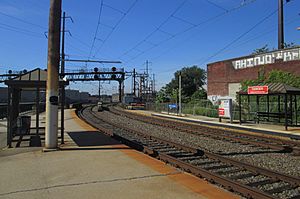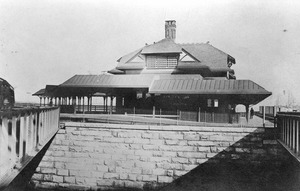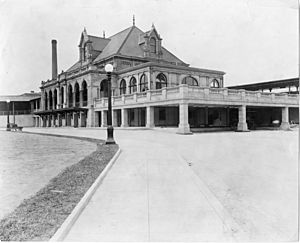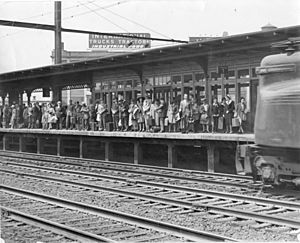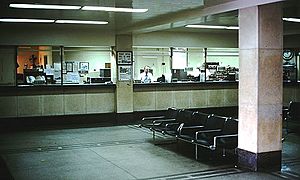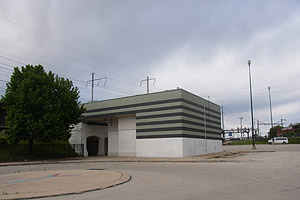North Philadelphia station facts for kids
Quick facts for kids
|
|||||||||||||||||||||||||||||||||||||||||||||
|---|---|---|---|---|---|---|---|---|---|---|---|---|---|---|---|---|---|---|---|---|---|---|---|---|---|---|---|---|---|---|---|---|---|---|---|---|---|---|---|---|---|---|---|---|---|
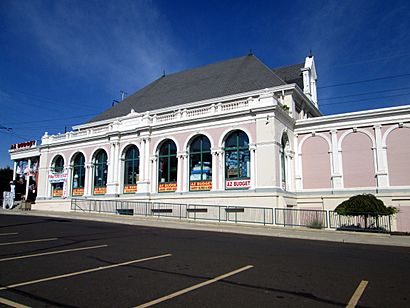
North Philadelphia station building in 2013
|
|||||||||||||||||||||||||||||||||||||||||||||
| Location | 2900 North Broad Street Philadelphia, Pennsylvania |
||||||||||||||||||||||||||||||||||||||||||||
| Coordinates | 39°59′51″N 75°9′16″W / 39.99750°N 75.15444°W | ||||||||||||||||||||||||||||||||||||||||||||
| Owned by | Amtrak | ||||||||||||||||||||||||||||||||||||||||||||
| Line(s) |
|
||||||||||||||||||||||||||||||||||||||||||||
| Platforms | 1 side platform, 1 island platform (Northeast Corridor) 2 side platforms (Chestnut Hill West Line) |
||||||||||||||||||||||||||||||||||||||||||||
| Tracks | 5 (Northeast Corridor) 2 (Chestnut Hill West Line) |
||||||||||||||||||||||||||||||||||||||||||||
| Connections | At North Philadelphia: Broad Street Line
|
||||||||||||||||||||||||||||||||||||||||||||
| Construction | |||||||||||||||||||||||||||||||||||||||||||||
| Parking | 333 spaces | ||||||||||||||||||||||||||||||||||||||||||||
| Disabled access | Yes | ||||||||||||||||||||||||||||||||||||||||||||
| Architect | Theophilus Parsons Chandler, Jr. Roydhouse Arey & Co. |
||||||||||||||||||||||||||||||||||||||||||||
| Architectural style | Renaissance | ||||||||||||||||||||||||||||||||||||||||||||
| Other information | |||||||||||||||||||||||||||||||||||||||||||||
| Station code | PHN (Amtrak) | ||||||||||||||||||||||||||||||||||||||||||||
| Fare zone | C (SEPTA) | ||||||||||||||||||||||||||||||||||||||||||||
| History | |||||||||||||||||||||||||||||||||||||||||||||
| Opened | 1870s (original station) | ||||||||||||||||||||||||||||||||||||||||||||
| Rebuilt | May 1896 – April 1901 (current station) 1912–1915 1955, 1977 1991 |
||||||||||||||||||||||||||||||||||||||||||||
| Traffic | |||||||||||||||||||||||||||||||||||||||||||||
| Passengers (2013) | 184 daily boardings (SEPTA) | ||||||||||||||||||||||||||||||||||||||||||||
| Passengers (FY 2018) | 2,006 |
||||||||||||||||||||||||||||||||||||||||||||
| Services | |||||||||||||||||||||||||||||||||||||||||||||
|
|||||||||||||||||||||||||||||||||||||||||||||
|
|||||||||||||||||||||||||||||||||||||||||||||
|
Germantown Junction Station
|
|||||||||||||||||||||||||||||||||||||||||||||
| NRHP reference No. | 92000940 | ||||||||||||||||||||||||||||||||||||||||||||
| Added to NRHP | July 8, 1999 | ||||||||||||||||||||||||||||||||||||||||||||
The North Philadelphia station is a busy train station in the North Philadelphia area of Philadelphia, Pennsylvania. It serves both long-distance trains (called intercity rail) and local commuter trains (called regional rail). The station is located on North Broad Street.
Most trains stopping here are from Southeastern Pennsylvania Transportation Authority's Regional Rail lines, specifically the Trenton Line and Chestnut Hill West Line. A few Amtrak trains also stop here on weekdays. The station first opened in the 1870s. It was known by different names, like New York Junction and Germantown Junction. A new, bigger station was built between 1896 and 1901. It was later renamed North Philadelphia. The station has been updated many times. In 1999, it was added to the National Register of Historic Places, which lists important historical places.
Contents
What the Station Looks Like and How it Works
The North Philadelphia station has different platforms for different trains.
- Two high platforms serve the Northeast Corridor tracks. These are used by most SEPTA Trenton Line trains and some Amtrak trains.
- Two lower platforms are a short distance away. These serve the Chestnut Hill West Line. Since 1993, trains on this line only stop here if a passenger asks them to.
Even though not many people start their journey here, many riders from the Chestnut Hill West Line use this station to switch to other SEPTA or Amtrak trains. This helps them get to jobs in New Jersey and New York.
The station is also close to other public transport options.
- The North Broad station is nearby. It's on SEPTA's Main Line.
- The North Philadelphia subway station is also close. It's on SEPTA's Broad Street Line.
| P Platform level |
||
| No service | ← Freight track, no passenger service → | |
| Outbound | ← Trenton Line toward Trenton (Bridesburg) ← Keystone Service limited service toward New York (Cornwells Heights) ← Northeast Regional limited service toward Boston or Springfield (Cornwells Heights) → |
|
| Island platform, doors will open on the left | ||
| Outbound | ← Trenton Line toward Trenton (Bridesburg) ← Amtrak services do not stop here |
|
| Inbound | Amtrak services do not stop here → | |
| Inbound | Northeast Regional limited service toward Norfolk, Newport News, or Roanoke (Philadelphia–30th Street) → Keystone Service limited service toward Harrisburg (Philadelphia–30th Street) → Trenton Line toward Temple University (Philadelphia–30th Street) → |
|
| Side platform, doors will open on the right | ||
| Side platform, doors will open on the right | ||
| Outbound | ← Chestnut Hill West Line toward Chestnut Hill West (Queen Lane) | |
| Inbound | Chestnut Hill West Line toward Temple University (Philadelphia–30th Street) → | |
| Side platform, doors will open on the right | ||
| G | Street level | Exit/entrance, buses, walkway between platforms |
History and Design of the Station
Early Days: Germantown Junction
The Pennsylvania Railroad (PRR) built a railway line called the Connecting Railway in 1867. This line linked its main route to another railroad. By the early 1870s, a station named New York Junction was built where these lines crossed. A signal tower from that time is still there today.
In the early 1880s, the PRR station became known as Germantown Junction. It was a two-story building with a Queen Anne style design. Its large roof sections offered shelter to passengers.
Building a New Station
By the mid-1890s, the station was very crowded. More people were moving to North Philadelphia and the nearby suburbs. A new bridge, the Delair Bridge, opened in 1896. This allowed trains to go directly to beach resorts in New Jersey. This meant even more people used the train line.
The railroad decided to build a new station. It was designed by Theophilus Parsons Chandler, Jr.. The new station was built on a former freight yard. This spot had more space and was better connected to new electric streetcar lines.
Work on the foundation began in May 1896. However, it stopped when the railroad president became ill and then passed away. Work started again in 1900 under a new president, Alexander Cassatt. He wanted to improve the main train lines and build large, grand stations. The new station was finished in April 1901.
Station Design and Style
The new Germantown Junction station was built in a style called Châteauesque. This was a new look for train stations along the Northeast Corridor. It helped start the Beaux Arts style for many large train stations built in the early 1900s.
The main entrance of the station faced Glenwood Avenue. It had a two-story covered walkway with seven arched openings. Inside, the first floor had a large waiting room. It had special glass blocks in the ceiling to let in natural light. There were also restrooms, a kitchen, and a cafe.
The basement held a smaller waiting room and baggage areas. Passengers could reach the train platforms through a tunnel from the main waiting room. There was also a covered ramp that led to a small trolley station.
Renamed North Philadelphia
After it was built, this station was the main stop in Philadelphia for many long-distance trains. This helped trains avoid having to turn around at other stations. It also served local trains. But within ten years, the station was crowded again.
In 1912, the PRR started a huge renovation project. The station's design was updated to be more modern.
- The ground level was lowered to make it easier for taxis and cars to access the station.
- A large canopy was added to shelter people arriving and leaving.
- The lower waiting room was made bigger, and a new ticket office was built.
- The floors were covered with fancy marble.
The old platforms were replaced with new, high platforms. These were long enough for twelve-car trains. The train line was also made wider, with eight tracks through the station. Some tracks were for fast, non-stop trains, and others for local freight trains. Each platform had a waiting room with skylights. A separate tunnel was built for baggage. When these big changes were finished in 1915, the station was renamed North Philadelphia.
Changes and Decline
North Philadelphia continued to grow in the early 1900s. It became a popular place to live. Sports stadiums and new cultural buildings were built nearby. In 1928, the Broad Street Subway opened with a station at North Philadelphia. This made it easier to get to the city center.
Even though another big station, 30th Street Station, opened in 1933, North Philadelphia station remained important for many years. It was used by many daily commuters and long-distance trains.
After World War II, the area around North Philadelphia station faced challenges. The railroad also started to offer fewer train services because more people were driving cars. This made the station less important. In 1955, escalators were added. The parking lots were also changed in 1968.
In 1977, after a fire, Amtrak fixed up the station. The roof was repaired, new restrooms were added, and parts of the waiting room were fixed. However, some windows and openings were covered up with cinderblocks.
New Station and Modern Use
In 1991, Amtrak built a smaller, new station building on the north side of the tracks. This new building was made of concrete and glass. The old access from the south side was blocked.
In 1999, the original station building was renovated for $7 million. It was turned into commercial space for businesses. The front parking lot was made bigger. The old station building was officially listed on the National Register of Historic Places on July 8, 1999.
In 2001, the Amtrak ticket office at the station closed. Elevators also closed due to vandalism. SEPTA thought about closing the station because it seemed to have few riders. However, a group of train passengers showed that many people used the station to switch trains. This convinced SEPTA to keep the station open.
In 2010, the North Philadelphia subway station was renovated. This included reopening old entrances, which made it easier to connect to the main train station.
Images for kids
- Amtrak – Stations – North Philadelphia, PA
- Historic American Buildings Survey listings:


